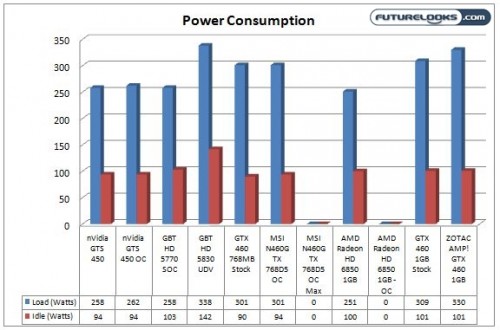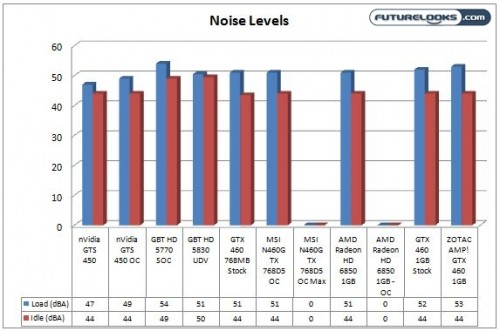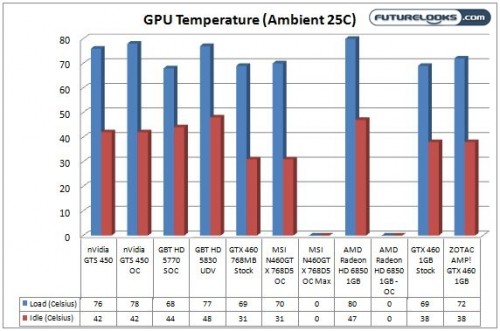Power Consumption
For the reasons we mentioned earlier in the review in the test notes, the consumption numbers for the overclocked to the limit MSI GTX N460GTX and the HD 6850 cards were omitted. Looking at the consumption numbers for the ZOTAC AMP! Edition GTX 460, the factory overclocked card does consume a good amount more energy than a stock card. I’m actually surprised that ZOTAC doesn’t recommend more than a 450W PSU in their system requirements. Even the MSI N460GTX lists a minimum of 550Watts. Of course, with an overlock of 895MHz on the MSI vs the 810MHz of the ZOTAC, plus the MSI is running more voltage, I’d estimate just under 400 watts consumption already.
What was really surprising is how much lower the power consumption is of the new HD 6850. At over 50 watts less consumption, it really provides a staggering amount of “performance per watt”. What’s great about that is that budget conscious gamers that don’t want to spring for a new power supply can consider the HD 6850 and still get a lot of performance. It’ll also cost less because you won’t have to replace a power supply.
Noise Levels
Again, due to the reasons cited in test notes, only the noise levels at stock speeds were recorded for the cards tested. Keep in mind that our “Stock” GTX 460s are actually just the ZOTAC and MSI underclocked. Even so, the excellent cooling solution on the MSI is much quieter than the ZOTAC’s cooling solution at load. But at idle, it was pretty much a wash between the two cards. One thing I can volunteer though, and I only found this out after the fact, is that the MSI’s cooling solution was no louder than stock even when overclocked. The cyclone cooler is definitely the better solution of the the two as far as noise go. But what about temperatures?
GPU Temperatures
The two cooling solutions definitely differ in performance. The MSI’s cyclone cooler was over 7C lower at idle and no hotter or cooler at load when we’re talking GPUs at the stock reference speeds. As I mentioned in the noise level section, I observed later that the MSI cyclone cooler didn’t emit any noise at its highest overclock and where it translated to on the graph was a temperature that was no different than its stock slight overclock. That means the MSI Cyclone cooler is way more efficient and much quieter all around.
So if you do overclock the snot out of this card, there are no worries that it will get too hot.
2D and 3D Image Quality

Wrapping up our miscellaneous sections of evaluations, we have to mention the things that people do at their computers pretty much 80% of the time. Unless you have a completely dedicated gaming rig, you’re probably using your computer for a bunch of other things besides gaming and I’m willing to bet that it’s probably either doing work, surfing the web or many other things that won’t stress the 3D prowess of your chosen GPU.
In the case of the GTX 460s, both the MSI and the ZOTAC exhibited the same level of image quality across the board. Neither was better than the other and that’s a good thing because that means that both cards are equally well built when run into the same Samsung LCD monitor with a 1920×1080 resolution. I also tested the HDMI port and again, I didn’t notice any difference in quality from a single monitor. However, once hooked up to my two regular 24 inch monitors that output at 1920×1200 you’ll notice that it just starts to go a bit fuzzy. Not a lot. Just enough to notice when you’re looking at things that should be completely black and sharp like text.
When gaming, you tend to notice these things less frequently which is an area that the GTX 460s clearly do well. But the elephant in the room is the HD 6850 and I can tell you right now that as far as sharp image, whether running one or two monitors, is crystal clear on the AMD card. In fact, every AMD (or ATI back then) video card has always been sharper than the nVidia counterpart. I notice this because I switch frequently with a KVM switch to the same monitor and always know which one it is. Just something to be aware of if more of your time is spent working in the 2D realm where you spend most of your time or if you plan on running more than one monitor most of the time; something that AMD does very well with their Eyefinity technology.



